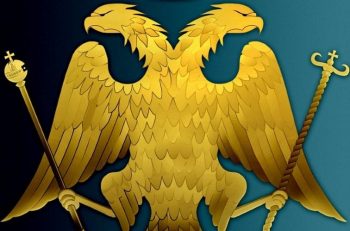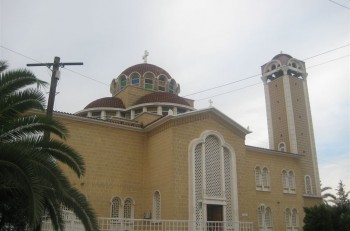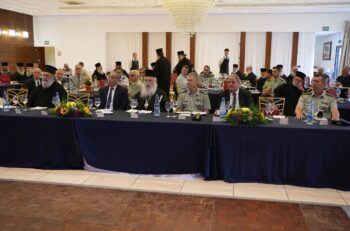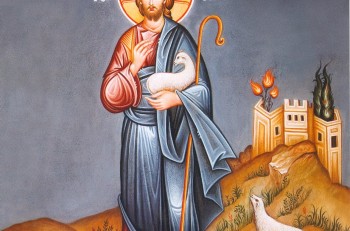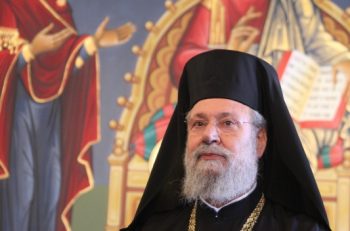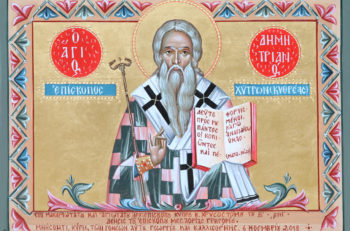Ο Μακαριώτατος λειτούργησε την Κυριακή της Ορθοδοξίας στον ι.ν. Αγίου Παντελεήμονος Μακεδονιτίσσης
Την Κυριακή της Ορθοδοξίας, 5 Μαρτίου 2017, η Α.Μ. ο Αρχιεπίσκοπος Κύπρου κ.κ. Χρυσόστομος προεξείρχε της Θείας Λειτουργίας του Μεγάλου Βασιλείου, συλλειτουργούντος του Επισκόπου Μεσαορίας κ. Γρηγορίου, στον ι.ν. Αγίου Παντελεήμονος Μακεδονιτίσσης.
Η Αγία Ορθόδοξος Εκκλησία, την πρώτη Κυριακή την νηστειών, ποιεί ανάμνηση της αναστήλωσης των ιερών Εικόνων, αφενόν μεν, κατά την Έβδομη – και τελευταία – Οικουμενική Σύνοδο το 787 μ.Χ., και αφετέρου δε κατά τη Σύνοδο Κωνσταντινουπόλεως το 843 μ.Χ.. Γι΄ αυτό και η σημερινή Θεία Λειτουργία είχε έναν επιπλέον λαμπρό και θριαμβευτικό χαρακτήρα, ο οποίος εκδηλώθηκε με τη λιτανεία των εικόνων από το πλήρωμα της Ορθοδόξου Εκκλησίας. Σήμερα, ο κλήρος μαζί με τον θεοσεβή λαό έψαλλαν το απολυτίκιο «Τὴν ἄχραντον Εἰκόνα σου προσκυνοῦμεν Ἀγαθέ, αἰτούμενοι συγχώρησιν τῶν πταισμάτων ἡμῶν, Χριστὲ ὁ Θεός· βουλήσει γὰρ ηὐδόκησας σαρκὶ ἀνελθεῖν ἐν τῷ Σταυρῷ, ἵνα ῥύσῃ οὓς ἔπλασας ἐκ τῆς δουλείας τοῦ ἐχθροῦ· ὅθεν εὐχαρίστως βοῶμέν σοι· Χαρᾶς ἐπλήρωσας τὰ πάντα, ὁ Σωτὴρ ἡμῶν, παραγενόμενος εἰς τὸ σῶσαι τὸν Κόσμον». Με αυτό το απολυτίκιο εκφράζουμε την ορθή διδασκαλία της Εκκλησίας, ότι δηλαδή, προσκυνώντας την Εικόνα του Κυρίου, δεν προσκυνούμε την ύλη, αλλά ο νους και η προσευχή μας απευθύνονται προς το πρωτότυπο της Εικόνας, δηλαδή στο δεύτερο Πρόσωπο της Αγίας Τριάδος, το Οποίο, σύμφωνα με το Απολυτίκιο, ενσαρκώθηκε και σταυρώθηκε για τη σωτηρία του κόσμου. Σε τελική ανάλυση, ολόκληρη η κτίση έχει εικονικό χαρακτήρα επειδή μας παραπέμπει στον Δημιουργό της, στον Τριαδικό Θεό.
Ο Μακαριώτατος στο κήρυγμα του θείου λόγου αναφέρθηκε στην ευαγγελική περικοπή, η οποία μας παρουσίασε την κλήση των Αποστόλων Φιλίππου και Ναθαναήλ. Η συνάντηση με τον Κύριο στη ζωή μας αποτελεί ένα τόσο χαρμόσυνο γεγονός, που επιθυμούμε να το μοιράσουμε και με άλλους. Η χαρά του Φιλίππου φάνηκε από το ότι αμέσως πήγε να πει και του Ναθαναήλ ότι βρήκε Εκείνον για τον οποίο έγραψαν ο Μωϋσής και οι Προφήτες: τον Ιησού από τη Ναζαρέτ. Ο Ναθαναήλ αρχικά δείχνει αμφιβολία σχετικά με την προέλευση του Ιησού, επειδή η Ναζαρέτ ήταν ένα μικρό και ασήμαντο χωριό της Γαλιλαίας. Δεν μπορούσε να φανταστεί ότι ο Μεσσίας, ο Σωτήρας του κόσμου, θα προερχόταν από ένα ασήμαντο μέρος. Ο Φίλιππος καλεί τον αμφίβολο Ναθαναήλ, όπως η Εκκλησία καλεί τον κάθε αμφίβολο άνθρωπο λέγοντας «ἔρχου καὶ ἴδε» (Ιω. 1, 46).
Απαντώντας στο κάλεσμα του Φιλίππου, ο Ναθαναήλ έρχεται και συναντά τον Χριστό, ο Οποίος του λέει ότι πριν να έρθει ο Φίλιππος να τον καλέσει, τον είδε να κάθεται κάτω από τη συκιά. Αυτή η λεπτομέρεια ήταν αρκετή για να πείσει τον Ναθαναήλ ότι όντως, το πρόσωπο που στέκει ενώπιόν του είναι ο Υιός του Θεού, ο βασιλεύς του Ισραήλ. Ο Χριστός όμως του απαντάει ότι θα δει μεγαλύτερα γεγονότα από αυτό που μόλις είδε. Θα δει τον ουρανό ανοικτό και τους Αγγέλους να ανεβοκατεβαίνουν επί τον Υιό του Ανθρώπου. Το άνοιγμα των ουρανών δηλώνει την πρόσβαση του ανθρώπου στα θεία. Η εικόνα που περιγράφει ο Κύριος δεν είναι μεταφορική και ούτε συμβολική αλλά μια ρεαλιστική περιγραφή της πνευματικής πραγματικότητας. Στη Θεία Λειτουργία ο ιερέας, κατά την Μικρή Είσοδο προσεύχεται, λέγοντας: «Δέσποτα Κύριε, ὁ Θεός ἡμῶν, ὁ κατασήσας ἐν οὐρανοῖς τάγματα καὶ στρατιὰς ἀγγέλων καὶ ἀρχαγγέλων, εἰς λειτουργίας τῆς σῆς δόξης, ποίησον σὺν τῇ εἰδόδῳ ἡμῶν, εἴσοδον ἁγίων ἀγγέλων γενέσθαι, συλλειτουργούντων ἡμῖν, καὶ συνδοξολογούντων τὴν σὴν ἀγαθότητα». Επίσης, ο Πρωτομάρτυρας Στέφανος, ενώ τον λιθοβολούσαν έλεγε, «ἰδοὺ θεωρῶ τοὺς οὐρανοὺς ἀνεῳγμένους καὶ τὸν υἱὸν τοῦ ἀνθρώπου ἐκ δεξιῶν τοῦ Θεοῦ ἑστῶτα» (Πραξ. 7, 56).
Ακολούθως, ο Μακαριώτατος τόνισε πως ο άνθρωπος για να συναντήσει – και φυσικά να αναγνωρίσει – τον Θεό χρειάζεται να έχει τους καρπούς του Αγίου Πνεύματος, τους οποίους αναφέρει ο Απόστολος Παύλος: «ὁ δὲ καρπὸς τοῦ Πνεύματός ἐστιν ἀγάπη, χαρά, εἰρήνη, μακροθυμία, χρηστότης, ἀγαθωσύνη, πίστις, πρᾳότης, ἐγκράτεια» (Γαλ. 5, 22). Αυτούς τους καρπούς, μάλλον, είχε και ο Ναθαναήλ για να καταφέρει να αναγνωρίσει στο πρόσωπο του Χριστού τον Υιό του Θεού, ο Οποίος τον επαίνεσε, λέγοντας: «ἴδε ἀληθῶς ᾿Ισραηλίτης, ἐν ᾧ δόλος οὐκ ἔστι».
Τέλος, ο Μακαριώτατος ευχήθηκε σε όλους να αξιωθούμε να λάβουμε τα δώρα του Αγίου Πνεύματος έτσι ώστε να μπορέσουμε κι εμείς να συναντήσουμε τον Κύριό μας Ιησού Χριστό.
Μετά τη δέηση και τα μνημόσυνα τελέστηκε η λιτάνευση των ιερών εικόνων στον περίβολο του Ναού του Αγίου Παντελεήμωνος. Οι πιστοί λιτάνευσαν τις ιερές εικόνες που έφεραν από το σπίτι του.
Ο Μακαριώτατος ανέγνωσε το Συνοδικό της Ορθοδοξίας. «Αὕτη ἡ πίστις τῶν Ἀποστόλων! Αὕτη ἡ πίστις τῶν Πατέρων! Αὕτη ἡ πίστις τὴν Οἰκουμένην ἐστήριξεν!»
Του Διακόνου Ανδρέα Ματέι
Γραφείο Ενημερώσεως και Επικοινωνίας της Εκκλησίας της Κύπρου
***********************************************
On the Sunday of Orthodoxy, 5th March 2017, His Beatitude Chrysostomos, the Archbishop of Cyprus, officiated the Divine Liturghy of Saint Basil the Great, with His Grace Gregorius, Bishop of Mesaoria, at the Church of St. Panteleimon in Makedonitissa.
The Orthodox Church, on the first Sunday of Lent commemorates the restoration of the Holy Icons, firstly, by the Seventh Ecumenical Council in 787 A.D (the last one), and secondly by the Constantinopolitan Synod held in 843 A.D. Therefore, today’s Liturgy has a brighter and more triumphant character, which was manifested through the litany of icons by the pleroma of the Orthodox Church. On this day, clergy along with the devout people sang the following apolytikion: “ We venerate Thy most pure icon, gracious Lord and ask forgiveness for our transgressions, O Christ our God. Of Thy good will Thou was pleased to ascend the cross in the flesh, and deliver from slavery to the enemy those whom Thou had fashioned. Therefore with thankfulness we cry aloud to Thee: Thou have filled all things with joy, O our Saviour, for Thou came to save the world”. By this hymn we express the correct teaching of the Church, that venerating the Icon of our Savior, we do not worship matter, but our minds and prayers ascend to the prototype of the Icon, ie. the second Person of the Holy Trinity, Who, according to the hymn, took human flesh (incarnated) and was crucified for the salvation of the world. In fact, the whole creation has an iconic character because it directs us to the Creator of all, to the Triune God.
His Beatitude Chrysostomos, at his sermon he referred to the evangelical pericope, which presented us the calling of Philip and Nathanael. The meeting with the Lord in our lives is an event of such joy, that we wish to share it with the others. Philip’s joy was manifested by his immediate announcing to Nathanael that he has found the One, that Moses and the Prophets wrote about: Jesus of Nazareth. At first, Nathanael shows some doubts about the origin of Jesus, since Nazareth was a small and insignificant village in Galilee. He could not imagine that the Messiah, the Savior of the world, would come from a place so small. Philip, called the doubter Nathanael, as the Church calls every man with doubts, by saying: “Come and see” (Jn. 1, 46).
Responding to the call of Philip, Nathanael comes and meets Christ, Who tells him that before Philip came to call him, He saw him sitting under the fig tree. This detail was enough to convince Nathanael that, indeed, the Person Who is standing before him is the Son of God, the King of Israel. However, Christ, replies that he would see greater thing that the one he just saw. He will see the heavens opened and the angels ascending and descending upon the Son of Man. The opening of the Heavens expresses the access of the man to the holy realities. The image that Christ describes is not a metaphorical or a symbolic one, but it is a realistic depiction of the spiritual dimension. In the Divine Liturgy, at the Small Entry, the priest prays: “Master and Lord our God, You have established in heaven the orders and hosts of angels and archangels to minister to Your glory. Grant that the holy angels may enter with us that together we may serve and glorify Your goodness”. Also, the Protomartyr and Archdeacon Stephen, while he was stoned to death, was saying: “Behold, I see the heavens opened, and the Son of man standing on the right hand of God” (Acts 7, 56).
Next, His Beatitude, emphasized that every man, in order to meet – and especially to recognize – God, needs the fruit of the Holy Spirit, which St. Paul enumerates: “But the fruit of the Spirit is love, joy, peace, longsuffering, gentleness, goodness, faith,Meekness, temperance” (Gal. 5, 22-23). It seems that Nathanael had these fruit, since he could recognize in the person of Christ the Son of God, Who lauded him by saying: “ Behold an Israelite indeed, in whom is no guile!”
Finally, His Beatitude Chrysostomos wished that we all be worthy to receive the gifts of the Holy Spirit, so that we can also meet our Lord Jesus Christ.
After the deisis and the memorial service, a litany with the holy icons was officiated outside the Church of St. Panteleimon. People held in their arms icons that they brought from home.
His Beatitude, read the Synodicon of Orthodoxy: “This is the Faith of the Apostles, this is the Faith of the Fathers, this Faith hath established the whole world”.
Deacon Andreas Matei
Office for Information and Communication of the Church of Cyprus
***************************************************
În Duminica Ortodoxiei, 5 Martie 2017, Preafericitul Părinte Hrisostom, Arhiepiscopul Ciprului, a săvârşit Sfânta Liturghie a Sf. Vasile cel Mare, împreună cu Preasfinţitul Părinte Grigorie, Episcopul de Mesaoria, la Biserica Sf. Pantelimon din Makedonitissa.
Biserica Ortodoxă, în prima Duminică din Postul Mare, comemorează restaurarea Sfintelor Icoane, în primul rând, prin Sinodul VII Ecumenic din 787 d.H. (şi ultimul), şi în al doilea rând, prin Sinodul Constantinopolitan din 843. De aceea, Liturghia de astăzi a avut, în mod special, un caracter mai luminos şi triumfător, care s-a manifestat prin litania icoanelor de către pleroma Bisericii Ortodoxe. Astăzi, clerul dimpreună cu poporul dreptcredincios au cântat troparul: “ Preacuratului Tău chip ne închinăm, Bunule, cerând iertare greşealelor noastre, Hristoase Dumnezeule. Că de voie ai binevoit a Te sui cu Trupul pe Cruce, ca să izbăveşti din robia vrăjmaşului pe cei pe care i-ai zidit. Pentru aceea, cu mulţumire strigăm Ţie: Toate le-ai umplut de bucurie, Mântuitorul nostru, Cel ce ai venit să mântuieşti lumea”. Prin acest tropar exprimăm învăţătura corectă a Bisericii, şi anume că închinându-ne Icoanei Mântuitorului, nu ne închinăm materiei, ci mintea noastră şi rugăciunea se înalţă către prototipul Icoanei, adică la a doua Persoană a Sfintei Treimi, care, potrivit troparului, S-a întrupat şi S-a răstignit pentru mântuirea lumii. În fond, întreaga creaţie are un caracter iconic, deoarece ne trimite la Ziditorul acesteia, la Dumnezeul Treimic.
Preafericitul Hrisostom, la cuvântul său de învăţătură, s-a referit la pericopa evanghelică, în care este relatată chemarea Apostolilor Filip şi Natanael. Întâlnirea cu Domnul în viaţa noastră constituie un eveniment de o bucurie atât de mare, încât dorim să o împărtăşim şi cu ceilalţi. Bucuria lui Filip s-a văzut din faptul că imediat a mers să-l anunţe pe Natanel că l-a găsit pe Acela despre care au scris Moise şi Proorocii: pe Iisus din Nazaret. Natanael, la început arată dubii în ceea ce priveşte provenienţa lui Iisus, deoarece Nazaret era un sătuc mic şi neînsemnat din Galileea. Nu-şi putea imagina că Mesia, Mântuitorul lumii, avea să vină dintr-un loc atât de nesemnificativ. Filip, îl cheamă pe îndoielnicul Natanael, aşa cum Biserica îl cheamă pe orice om cu îndoieli, zicându-i: “Vino şi vezi!” (In. 1, 46).
Răspunzând la chemarea lui Filip, Natanael vine şi îl întâlneşte pe Hristos, Care îi spune că înainte de a veni Filip să-l cheme, L-a văzut stând sub smochin. Acest detaliu a fost de-ajuns ca să-l convingă pe Natanael că, într-adevăr, Persoana care stă în faţa lui este Însuşi Fiul lui Dumnezeu, Împăratul lui Israel. Hristos, însă, îi răspunde că va vedea lucruri mai mari decât ceea ce tocmai a văzut. Va vedea cerurile deschise şi pe îngeri urcându-se şi coborându-se peste Fiul Omului. Deschiderea cerurilor exprimă accesul omului la cele sfinte. Imaginea pe care o descrie Mântuitorul nu este metaforică sau simbolică, ci este o descriere realistă a adevărurilor duhovniceşti. În Sfânta Liturghie preotul, la Vohodul Mic, se roagă, spunând: “Stăpâne Doamne Dumnezeul nostru, Cel ce ai aşezat în ceruri cetele şi oştile îngerilor şi ale arhanghelilor spre slujba slavei Tale, fă ca împreună cu intrarea noastră să fie şi intrarea sfinţilor îngeri care împreună cu noi slujesc şi împreună slăvesc bunătatea Ta“. De asemenea, Întâiul Mucenic şi Arhidiacon Ştefan, în timp ce era omorât cu pietre, spunea: “Iată, văd cerurile deschise şi pe Fiul Omului stând de-a dreapta lui Dumnezeu!” (Fapt. 7, 56).
În continuare, Preafericirea Sa, a accentuat faptul că omul, pentru a-l întâlni – şi mai ales pentru a-l recunoaşte – pe Dumnezeu are nevoie de roadele Duhului Sfânt, pe care le enumeră Sf. Apostol Pavel: “Roada Duhului este dragostea, bucuria, pacea, îndelunga-răbdare, bunătatea, facerea de bine, credinţa, blândeţea, înfrânarea, curăţia” (Gal. 5, 22-23). Se pare că Natanael avea aceste roade din moment ce a putut să recunoască în persoana lui Iisus pe Fiul lui Dumnezeu, Cel care L-a lăudat, spunându-i: “Iată cu adevărat Israelit în care nu este vicleşug”.
La sfârşit, Preafericitul Părinte Hrisostom, a urat ca toţi să ne învrednicim să primim darurile Duhului Sfânt, aşa încât să putem să-l întâlnim şi noi pe Domnul nostru Iisus Hristos.
După săvârşirea pomenirilor şi parastasului, s-a făcut litanie cu Sfintele Icoane în incinta Bisericii Sf. Pantelimon. Credincioşii au ţinut în mâini icoanele aduse de acasă.
Preafericitul a citit Synodiconul Ortodoxiei: “Aceasta e credinţa Apostolilor! Aceasta e credinţa Părinţilor! Aceasta e credinţa care a întărit lumea”.
Diaconului Andrei Matei
Biroul de Informaţii şi Comunicare al Bisericii Ciprului























